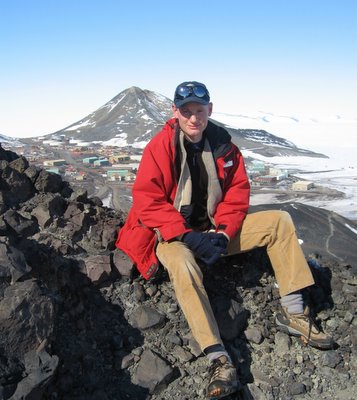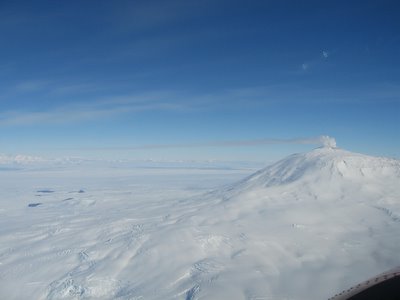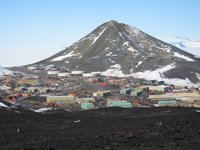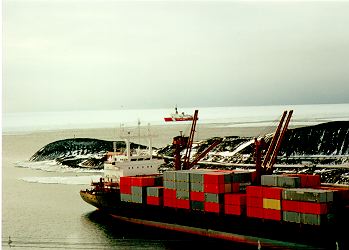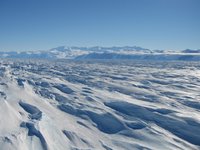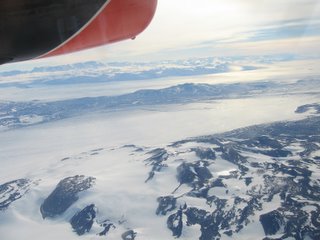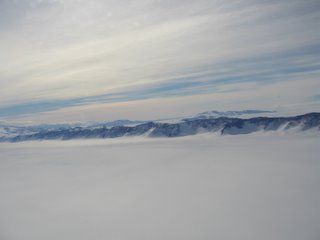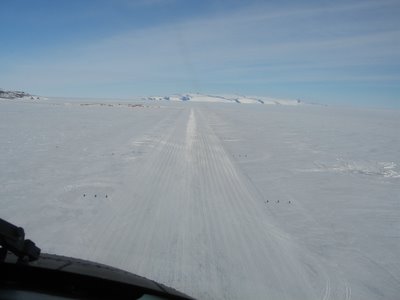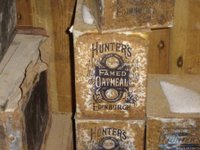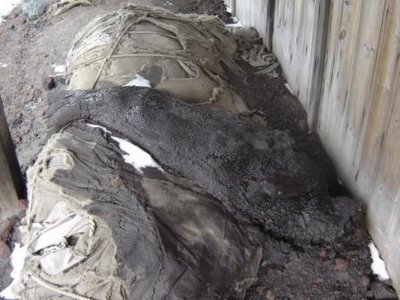 Happy camper school was a lot more fun than I thought is was going to be. The whole idea of HC school is to teach the scientists and staff here what to do if they find themselves stranded out in the field. Away from station with only thing things in a survival kit. This could happen if you are traveling by helicopter or Delta or snowmobile to a remote field camp and something bad happens. For our project, if you want to fly on the Twin Otter (which is flying hundreds of miles from station) and the plane has problems, then you might find yourself camping out in the cold. I am not afraid of camping out in the snow. I have spent over 12 weeks camping in a tent on the Summit of the Greenland ice sheet as part our research up there. The difference is that if something goes wrong in Greenland, I can always walk less than a quarter mile to the "Big House" to get out of the elements. It could be cold in there, but better than being in a tent. With our work in Antarctica we could find ourselves stranded a long way from station and it could be a few days before help arrives. So while I wasn't scared of sleeping in a tent I knew that I wasn't prepared to be stranded in the middle of nowhere.
Happy camper school was a lot more fun than I thought is was going to be. The whole idea of HC school is to teach the scientists and staff here what to do if they find themselves stranded out in the field. Away from station with only thing things in a survival kit. This could happen if you are traveling by helicopter or Delta or snowmobile to a remote field camp and something bad happens. For our project, if you want to fly on the Twin Otter (which is flying hundreds of miles from station) and the plane has problems, then you might find yourself camping out in the cold. I am not afraid of camping out in the snow. I have spent over 12 weeks camping in a tent on the Summit of the Greenland ice sheet as part our research up there. The difference is that if something goes wrong in Greenland, I can always walk less than a quarter mile to the "Big House" to get out of the elements. It could be cold in there, but better than being in a tent. With our work in Antarctica we could find ourselves stranded a long way from station and it could be a few days before help arrives. So while I wasn't scared of sleeping in a tent I knew that I wasn't prepared to be stranded in the middle of nowhere.
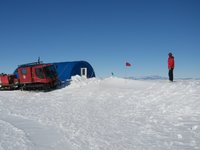 Photo of the guy in blue dragging a Scott Tent is Trevor, our happy camper instructor. He is over qualified for this job has he has lead mountain climbing expeditions all around the world. Seems like he might sleep half his nights outdoors in a given year. In any case, the day started out pleasant enough with cloudy conditions and a little bit of snow as the 12 of us rode in the Delta from McMurdo out past the Scott Base to Happy Camper School on the Ross Ice Shelf. As we hung out in the instructor hut (aka the I-Hut, the blue Jamesway on the left) and learned how to light a stove and to use the VHF and HF radios it started to snow a little bit more and it started to snow a bit more. Then we went outside tested are radio skills by trying to call the South Pole. One of our radios didn't work, which was a valuable lesson to test you equipment before you go into the field. With the other radio we were finally able to call the Pole and chat with them. Jim Crawford got to tell the Pole-Ops (South Pole Operations Center) to keep a look out for the Kenn Borek Twin Otter (with tail number SJB) that was heading their way.
Photo of the guy in blue dragging a Scott Tent is Trevor, our happy camper instructor. He is over qualified for this job has he has lead mountain climbing expeditions all around the world. Seems like he might sleep half his nights outdoors in a given year. In any case, the day started out pleasant enough with cloudy conditions and a little bit of snow as the 12 of us rode in the Delta from McMurdo out past the Scott Base to Happy Camper School on the Ross Ice Shelf. As we hung out in the instructor hut (aka the I-Hut, the blue Jamesway on the left) and learned how to light a stove and to use the VHF and HF radios it started to snow a little bit more and it started to snow a bit more. Then we went outside tested are radio skills by trying to call the South Pole. One of our radios didn't work, which was a valuable lesson to test you equipment before you go into the field. With the other radio we were finally able to call the Pole and chat with them. Jim Crawford got to tell the Pole-Ops (South Pole Operations Center) to keep a look out for the Kenn Borek Twin Otter (with tail number SJB) that was heading their way.
 Then we gathered up some sleeping bags, tents, and tools (shovels, saws, snow axes, sleds) and headed out to our campsite. By now we could not see more than a 1/2 mile and the wind was starting to pick up. As we started to set up camp, we heard that we were now in Condition 2. And we could see less than 1/4 mile. The weather rapidly got worse, and as the winds picked up we could barely see 30 feet. After we got up the first Scott Tent. Trevor sent Jim Crawford (Guy with the beard on the left) and Dan Rudd out to set up a line of flags to make sure we could find our way back to the road and the outhouse. Jim said they could only see about 2 flag lengths at a time. So they had to be sure to stick together. After the
Then we gathered up some sleeping bags, tents, and tools (shovels, saws, snow axes, sleds) and headed out to our campsite. By now we could not see more than a 1/2 mile and the wind was starting to pick up. As we started to set up camp, we heard that we were now in Condition 2. And we could see less than 1/4 mile. The weather rapidly got worse, and as the winds picked up we could barely see 30 feet. After we got up the first Scott Tent. Trevor sent Jim Crawford (Guy with the beard on the left) and Dan Rudd out to set up a line of flags to make sure we could find our way back to the road and the outhouse. Jim said they could only see about 2 flag lengths at a time. So they had to be sure to stick together. After the  2nd Scott tent was up, Trevor taught us how to build an snow wall to protect us from the wind and create a space to set up the mountain tents. I was surprised how easy it was with people all working together. In a matter of 2-3 hours or so, we had all the tents up and Jim Pierce had the stoves on and was melting snow for us so we could make some hot chocolate.
We were pretty busy hauling snow blocks and fighting the wind will setting up our tents that we did not take many pictures. Normally snow school students are supposed to build a Quinzee, an igloo like structure but because the weather was so bad, Trevor let us off the hook.
Fortunately, there were a couple of Quinzees near our camping area from previous Happy Camper classes.
So we all picked a place to sleep, and went over to the cook tent to enjoy a dehydrated meal. Two choices were beans and rice or chicken and rice. They were not that bad, but I would not want to live off of them for a more than a few days. Will, Jim, and I (the 3 ANTCI campers) shared the larger mountain tent. It was a bit cozy, but super warm with the sleeping bags they gave us. I was a bit noisy with high winds blowing the tents around, but thankfully the wind died down after midnight and I was able to fall asleep. While Trisha, Estiban, Jim, and Peter divided among the other tents, 4 members of our group (Andre, Mike, Laura and Megan) decided to sleep two of the Quinzees and Dan slept in a snow trench. Sounds cold, but Dan swears he was comfortable. The survival kit only has a couple of small tents, so chances are if you are stranded in Antarctica, some of your party is going to have to sleep in a snow trench. If I every get a chance to do this again, I'll try to snow trench.
2nd Scott tent was up, Trevor taught us how to build an snow wall to protect us from the wind and create a space to set up the mountain tents. I was surprised how easy it was with people all working together. In a matter of 2-3 hours or so, we had all the tents up and Jim Pierce had the stoves on and was melting snow for us so we could make some hot chocolate.
We were pretty busy hauling snow blocks and fighting the wind will setting up our tents that we did not take many pictures. Normally snow school students are supposed to build a Quinzee, an igloo like structure but because the weather was so bad, Trevor let us off the hook.
Fortunately, there were a couple of Quinzees near our camping area from previous Happy Camper classes.
So we all picked a place to sleep, and went over to the cook tent to enjoy a dehydrated meal. Two choices were beans and rice or chicken and rice. They were not that bad, but I would not want to live off of them for a more than a few days. Will, Jim, and I (the 3 ANTCI campers) shared the larger mountain tent. It was a bit cozy, but super warm with the sleeping bags they gave us. I was a bit noisy with high winds blowing the tents around, but thankfully the wind died down after midnight and I was able to fall asleep. While Trisha, Estiban, Jim, and Peter divided among the other tents, 4 members of our group (Andre, Mike, Laura and Megan) decided to sleep two of the Quinzees and Dan slept in a snow trench. Sounds cold, but Dan swears he was comfortable. The survival kit only has a couple of small tents, so chances are if you are stranded in Antarctica, some of your party is going to have to sleep in a snow trench. If I every get a chance to do this again, I'll try to snow trench.
 The next morning is was beautiful out, bright and sunny and no clouds to be seen. We packed up camp in less than 2 hours and then had a chance to explore the neighborhood. Here is photo of Will crawling through the entrance to a Quinzee. Then Trevor arrived with the Delta to pick up all the equipment. We went back to the I-Hut and he showed us how to make a Quinzee and then tested us on our survival skills. He gave us a survival kit and said that we had 20 minutes to set up the tent, set up the radio and place a call to the South Pole, build a snow wall, and melt a liter of snow. So we all split up and get everything going. We selected a patch of snow for our "snow quarry" that was more like concrete. While that wasted some time, 25 minutes later we had everything accomplished. I have to admit after taking the class, I feel a lot better about how I would do if I found myself stuck away from McMurdo.
The next morning is was beautiful out, bright and sunny and no clouds to be seen. We packed up camp in less than 2 hours and then had a chance to explore the neighborhood. Here is photo of Will crawling through the entrance to a Quinzee. Then Trevor arrived with the Delta to pick up all the equipment. We went back to the I-Hut and he showed us how to make a Quinzee and then tested us on our survival skills. He gave us a survival kit and said that we had 20 minutes to set up the tent, set up the radio and place a call to the South Pole, build a snow wall, and melt a liter of snow. So we all split up and get everything going. We selected a patch of snow for our "snow quarry" that was more like concrete. While that wasted some time, 25 minutes later we had everything accomplished. I have to admit after taking the class, I feel a lot better about how I would do if I found myself stuck away from McMurdo.

 Sorry for the late reply. I did not have good internet access while in New Zealand. They do have good internet cafes, but the place I went to did not have a way for me to upload my photos.
Anyway, after a delay we flew from McMurdo back to Christchurch on a Kiwi C-130. The most exciting part of the trip was when our shuttle van got stuck in the ice on the trip from McMurdo Station out to the aircraft on the ice runway. The ice is starting to melt and in the transition between the land and the ice was particularly soft. Luckily a bulldozer was nearby and able to quickly pull us out so we did not miss our flight.
It was a 8-hour flight and pretty crowded, but we were all happy to be on our way home. My
Sorry for the late reply. I did not have good internet access while in New Zealand. They do have good internet cafes, but the place I went to did not have a way for me to upload my photos.
Anyway, after a delay we flew from McMurdo back to Christchurch on a Kiwi C-130. The most exciting part of the trip was when our shuttle van got stuck in the ice on the trip from McMurdo Station out to the aircraft on the ice runway. The ice is starting to melt and in the transition between the land and the ice was particularly soft. Luckily a bulldozer was nearby and able to quickly pull us out so we did not miss our flight.
It was a 8-hour flight and pretty crowded, but we were all happy to be on our way home. My  wife Maggie was waiting for me in Christchurch. And we spent a few days exploring the south island. We went visited some old volcanoes near Christchurch, went to the beach and a harbor cruise (where we saw a bunch of dolphins).
We also took the train to the "Southern Alps" of New Zealand and spent some time hiking (or "tramping" as the Kiwi's say) around some of the areas they filmed Lord of the Rings. Then we flew to the North Island and visited our friends Nancy and Bryan. They moved from Boulder to New Zealand a couple of years ago and we had a really fun time touring and hiking around the North Island with them.
wife Maggie was waiting for me in Christchurch. And we spent a few days exploring the south island. We went visited some old volcanoes near Christchurch, went to the beach and a harbor cruise (where we saw a bunch of dolphins).
We also took the train to the "Southern Alps" of New Zealand and spent some time hiking (or "tramping" as the Kiwi's say) around some of the areas they filmed Lord of the Rings. Then we flew to the North Island and visited our friends Nancy and Bryan. They moved from Boulder to New Zealand a couple of years ago and we had a really fun time touring and hiking around the North Island with them.
 I had a really had a great trip South, but glad to be back home. I have another field trip coming up in February when study the Mexico City air pollution problem. Take care. Barry
I had a really had a great trip South, but glad to be back home. I have another field trip coming up in February when study the Mexico City air pollution problem. Take care. Barry
